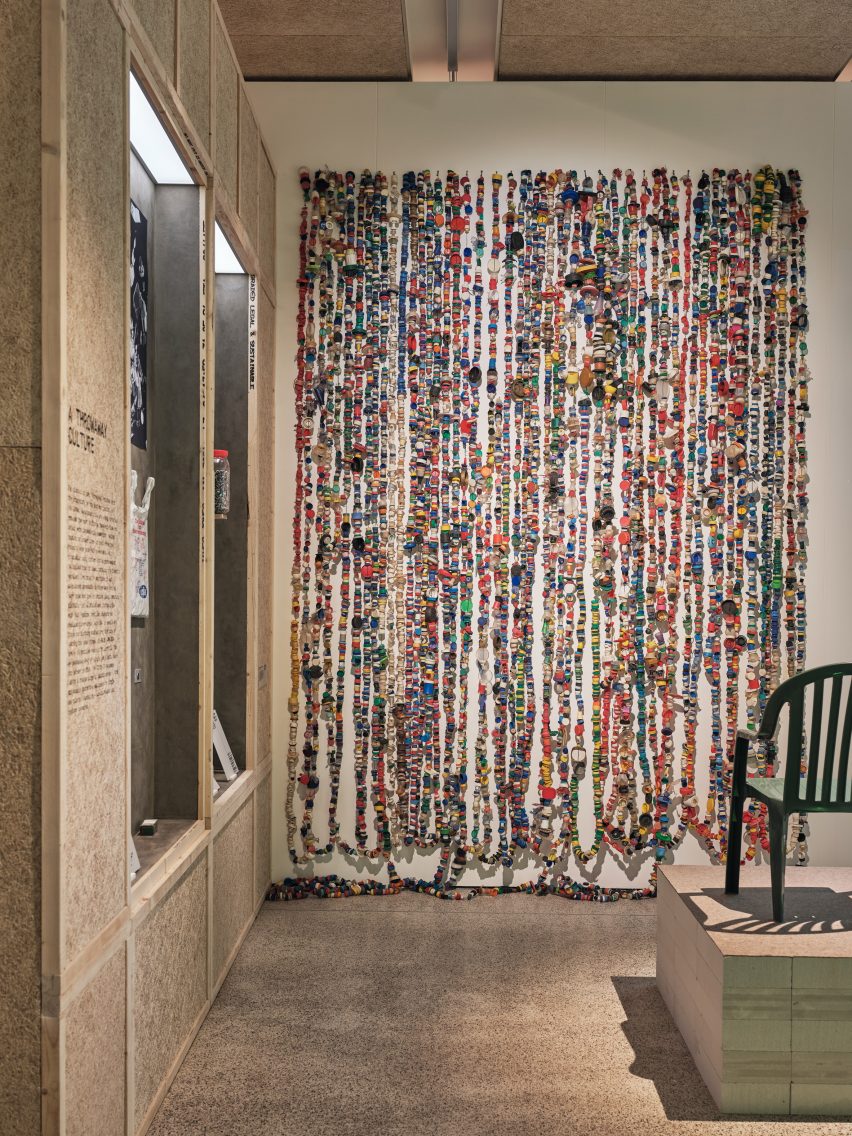
Waste crisis a "design-made mess" says Design Museum show curator
The Waste Age exhibition, which opens today at London's Design Museum, explores how design has contributed to the rise of throwaway culture and how the industry can help to create an alternative circular economy that doesn't exploit the planet.
Across three sections and more than 300 objects, it takes stock of the global waste crisis as well as presenting a range of possible solutions developed by product, fashion and building designers using reclaimed and natural materials.
The exhibition's core thesis is that, much like humanity had the stone age and the steam age, we now live in a waste age defined by convenience and single-use, disposable products.

"Waste is something that we tend to think of as on the periphery and that's where we prefer it, out of sight and out of mind," said the Design Museum's chief curator Justin McGuirk.
"But what if waste isn't peripheral? What if it's absolutely central to the culture that we've created?"

Timed to coincide with the UN's upcoming COP26 conference, the exhibition seeks to establish waste as a key focus point for designers in the fight against climate change.
"We wanted to focus on the waste issue because we think that's where design has the biggest impact," McGuirk told Dezeen.
"When you talk about carbon emissions, there are things designers can help with but it's not really a design issue. Whereas when you think about waste, most waste happens in the making of products."

"This is, in a way, a design-made mess," agreed the show's curator Gemma Curtain. "But we can certainly change the way we react in the future."
In this spirit, the exhibition design by local studio Material Cultures focuses on renewable materials and repurposes components from the museum's recent Charlotte Perriand exhibition, while Sophie Thomas of climate collective URGE is conducting an environmental audit of the show to assess its footprint.
"It's a show about how we rethink design at every level and look to a future where we create less waste," said McGuirk. "That's not going to mean just recycling. It's going to be a whole shift towards growing materials rather than extraction."

Before visitors enter the exhibition, they are greeted by a newly commissioned installation from architect Arthur Mamou-Mani, which is suspended in the Design Museum foyer and explores how PLA bioplastic and wood pulp can be 3D printed to create recyclable building materials.
The first section, titled Peak Waste, traces the rise of convenience culture starting from the Industrial Revolution, with the advent of disposable plastics and design strategies such as planned obsolescence.

"Humans are not by nature wasteful beings, we had to be taught wastefulness," McGuirk told Dezeen.
"There are anecdotes about people in the 50s holding on to plastic bags and meal trays and they had to be told, through ads, that it was okay to throw them away, that they weren't anything of value," he continued.
"So the plastics industry thrived. But we've been set up to fail."
This introductory section showcases some of the earliest examples of disposable cutlery and plastic water bottles, as well as visualising the scale of the global waste crisis.
A new commission from artist Ibrahim Mahama incorporates e-waste from Ghana's notorious Agbogbloshie rubbish dump and examines the failings of the current waste management system, which sees rubbish from the West "dumped on poor countries" in Africa and Southeast Asia.
The second section, titled Precious Waste, charts work from designers and architects that treats waste as an abundant resource to be exploited.

It starts by showing everyday objects such as an iPhone or Volkswagen Beetle as the sum of their constituent materials, in a series of works from Studio Drift's Materialism series.
From here, it goes on to showcase designs made from reclaimed materials including Snøhetta's marine plastic chair S-1500, bricks formed from construction scraps and Phoebe English garments with Codelite buttons made from milk curds that would otherwise have been discarded.
Architecture is also represented through projects such as Lacaton & Vassal's renovation of a 1960s housing estate in Bordeaux, France.

"I think they're some of the most important architects working today because they don't believe in demolition," McGuirk said. "The sheer waste of embodied carbon and energy is ludicrous."
The final part of the exhibition looks towards a "post-waste" future, highlighting experimental projects that substitute the extractive, emissions-intensive materials of the 20th century for natural, renewable and often biodegradable alternatives.
Among them is Totomoxtle, a wood substitute derived from corn husks, a couture dress by Charlotte McCurdy and Phillip Lim covered in algae bioplastic sequins and an architectural column by Blast Studio made from waste coffee cups that were fed to mushroom mycelium, turned into sludge and subsequently 3D printed.

This last section also takes a look at initiatives that are overhauling the systems surrounding waste, from a case study on Japan's first zero-waste town to Framework, a modular laptop that can be easily repaired and upgraded much like a Fairphone.
"We don't have an economy that helps people fix or recycle things, so of course they take the path of least resistance and they throw those things away," McGuirk explained.
"The message coming from corporations is that it's down to consumer behaviour but we took the position with this exhibition that consumers just aren't presented with viable choices. And things are made to last for brief periods of time, so the whole system is broken."
Photography is by Felix Speller.
Waste Age is on view at the Design Museum in London until 20 February 2022. See Dezeen Events Guide for an up-to-date list of architecture and design events taking place around the world.